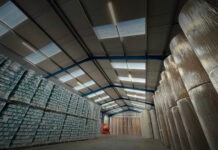Industry analyst Greg Grishchenko – comparing the reality to sometime public perception – reveals just how responsible the industry has been with its forestry and bleaching programmes.

An average American household is ahead of households in every nation on earth in consuming tissue goods. Indeed, according to the German market research platform Statista, a person in the US on average uses about three rolls of toilet paper every week.
If multiplied by days and head count it comes to $16bn in the toilet paper revenue segment for the year 2023 (Statista). In purely volume terms, this amount comes second to a record breaking $22.3bn for China. Considering population size difference, America will keep its place in toilet paper consumption for years to come.
While 90% of bath tissue is North America is made from local sources and by local manufacturers, the remaining share of the market represents an attractive opportunity for small business enterprises both domestic and foreign to fill this niche. Ways and means of such businesses mostly based on environmental concerns merged conveniently with the modern world’s health and political issues. The competitive economic part in its marketing models may or may not always prevail.
Scorecard – winners and losers
Recently released is the latest (2022) annual report from the US-based Natural Resources Defense Council (NRDC), a half-century old non-profit international environmental advocacy group, with its ranking of sixty top toilet paper brands sold in the country. The scoreboard – The issue with tissue 4.0 scorecard: A buyer’s guide to the sustainability of At-Home tissue products – aims to show how ecologically-friendly our choice brands are and provides grade ranking from A+ to F.
The NRDC scoring system which was used on toilet paper brands is awarding the highest score of up to 600 points to non-users of virgin wood fibre and harmful chemical technology like chlorine bleaching. Additional points are given for utilising recycled “post-consumer” materials or non-wood fibre like sugarcane bagasse, bamboo, or wheat straw. Some scoring points can be won also for “pre-consumer” recycled matter, employed internally during production process. Still the entire score for the latter is lower than that for “pre-consumer”, which is given for recycled items coming from eco-conscious people.
Only four toilet paper brands received A+ rating. The “champion” brands are Green Forest, Natural Value and two private labels from health food grocers Trader Joe’s and Whole Foods. All of them use 100% recycled fibre. There is just one brand included in the second tier with B+ and B rating coming from one of the major market players, Kimberly-Clark – Scott Essential, with 100% recycled content. The rest represent several bamboo paper suppliers with brand names like Cheeky Panda, NooTrees and Who Gives a Crap (WGAC). The latter displays an impressive list of “green” and political claims including 100% bamboo sourcing, biodegradability, carbon neutral shipping and 50% profits donation to sanitation improvements in the developing world. One issue is whether NRDC takes into account the carbon neutrality of the online brand shipped by the Australian company from Chinese production sites using process bleaching.
The failing grade F was given to almost a bottom half of the list, best-selling brands including Charming, Angel Soft, Cottonelle Ultra and Scott 1000. According to NRDC, the “losers” of the product line-up were given the lowest possible score for bringing deforestation and pollution to our habitat by using entirely virgin wood fibre and chlorine bleaching.
Habitat and humans
Inevitably, as humankind improves living conditions through the production of food and other goods, population numbers increase and our surroundings and environment change. Tissue, a segment of a much larger paper industry, is sometimes charged with being largely responsible for damage to our forests. Numerous government, public and private organisations have been established to protect wild forests and mitigate the negative impact of the paper industry on global climate, wildlife and indigenous people. We can only speculate as to why tissue goods are singled out for criticism, but not the other sectors like log houses, or art books of children’s toys – the latter is made of 100% natural wood in China from Russian pine trees growing in Siberia. Probably, short life cycle, and disposability create that image.
Let’s consider a few facts about deforestation. Both owners of F-grade rated brands Charming and Angel Soft – Procter & Gamble and Georgia-Pacific – declare replanting two or three trees (respectively) for every tree they cut.
According to Statista, for 900m trees that are harvested annually about 2.5bn trees are replanted. NRDC often contests the value of tree replanting, claiming that the areas where wild forests were clear-cut and replanted by paper corporations are not ecologically equal for wild life species.
In the meantime, only this year 20m acres of Canadian boreal forest were lost due to catastrophic wildfires, and it is impossible to reforest it to the level previously used. Replanting value allegations could be raised for natural events (including wildfires) taking place in North America every year from May to October. Still the guilt has been laid on paper companies.
Bleaching in modern tissue production, often seen by public opinion as an environment polluter, is also misunderstood. Nowadays in North America, not a single considerable tissue manufacturer uses elemental chlorine. Instead, they either apply “totally chlorine-free” (TCF) or “elemental chlorine-free” (ECF) technology. TCF pulp has been bleached without any type of chlorine. ECF process uses chlorine derivatives especially for recycled fibre and bamboo imports due to high amounts of inks and dyes.
Politics, health and public opinion
Seventh Generation brand is a success story of a brand with A rating from NRDC. This brand was originated and developed almost entirely on human perception of preserving nature. According to Jeffrey Hollender, the founder of Seventh Generation, the marketing concept of the start-up company began with sending the brand promotion materials to the mailing list of people who made donations to various funds associated with ecological causes.
Many years ago while visiting a major tissue producer in Canada, I noticed a Seventh Generation bath tissue packaging line at one of the affiliated mills. At the end of my visit, I was asked not to disclose any reference to this brand in my trip report. This request was not unusual due to the fact that often private label brands prefer to keep their manufacturing sources confidential.
Indeed, many “green” brands are manufactured by big paper companies using their venue and technology. The sourcing of such brands and their affiliation with major tissue mills, especially located in Asia, remains the best kept secret.
Another hidden point that never comes to light is a carbon footprint. While the negative impact of CO2, the most commonly produced greenhouse gas, has never been denied in paper manufacturing, the similar result of selling imported tissue goods from faraway places has been somehow missing. The majority of B-graders in NRDC score card, non-wood fibre brands (mostly bamboo or sugarcane) are sourced in Asian countries like China or India. Shipping jumbo rolls or finished bath tissue rolls made of compostable and biologically friendly items halfway across the globe will generate quite large carbon footprints – and ones that have not been considered by promoters of “green” issues.
Even though the majority of American bath tissue consumers establish purchasing decision almost entirely on cost and tactile perception, the annual brand scoring review from NRDC represent its powerful opinion based almost entirely on nature protection while mostly ignoring consumers’ health issues rising from the use of recovered paper. While recycled paper is considered the best option for the environment, there is one stealthy little secret in secondary paper essence – bisphenols, used to produce polymers and resins such as BPA and BPS, which are then used to make plastic materials.
BPA and BPS have been discovered as a hideaway inside recycled bath tissue. (Yet it is important to note that Bisphenol compounds are found throughout the contemporary world in the form of plastics used extensively by consumers for food storage, baby formula, dental implants, sales receipts, shatterproof windows, eyewear, water bottles, and epoxy resins that coat some metal food cans, bottle tops, and water supply pipes, etc.)
In recycled bath tissue, this issue is linked to thermal paper (as well as the other printed secondary paper) which is contaminated with bisphenols and ends up in mixed post-consumer stock material. Bisphenol A (BPA) is an endocrine disruptor. Studies have linked them to breast cancer, reproductive problems, and early puberty.
Recently, the state of the tissue business in North America was tested for vulnerabilities during the Covid pandemic. The results were mostly encouraging. The major players and F-graders (according to NRDC) like Procter & Gamble, Georgia-Pacific and Kimberly-Clark have shown the ability to bring the comfort of recovery to a scared consumer, while A-graders struggled to adjust due to their distinct business models.

































